内容详细
- 国际实验室系列讲座12—新加坡国立大学化学系徐清华教授
- 发布时间:2012-05-31 点击次数:1
-
2012年5月30日上午9点,国际实验室系列学术讲座2012年第六期在A718室举行,本次讲座邀请到新加坡国立大学化学系徐清华教授来苏州纳米所进行学术交流。徐清华教授作了题为 “Nanocomposite Materials for Two-photon Excitation Applications”学术报告。报告会由部门主任陈立桅研究员主持,相关科研人员和学生聆听了报告。与传统的单光子激发技术相比,双光子激发技术在三维选择性和生物组织深度穿透方面有其特殊的优势,徐清华教授的报告主要介绍了如何利用纳米复合材料来增强双光子激发性能的最新研究进展及其各种应用。制备用于双光子激发技术的纳米复合材料徐教授课题组主要是基于两种途径,一种途径是基于具有高双光子吸收截面的共轭高分子作为能量传输媒介,增强双光子吸收效率并成功用于双光子探测,成像和光动力学疗法等方面;另一种途径是利用贵金属纳米颗粒的等离子体共振性质设计的复合材料来提高双光子的激发和发射性能,并成功应用于双光子探测方面。报告摘要:Two-photon excitation techniques have unique advantages, such as 3-D selectivity and deep penetration into biological tissues, compared to their one-photon counterparts. In this talk, I will present our recent research work on nanocomposite materials with enhanced two-photon excitation properties and their various applications. We used two different strategies to develop nanocomposites with enhanced two-photon properties. One method is based on energy transfer from conjugated polymers, which have large two-photon absorption cross sections. We have used conjugated polymers as two-photon light harvesting complexes to develop schemes for two-photon sensing, imaging and photodynamic therapy. The second approach is to develop plasmon engineered nanocomposite materials. Noble metal nanoparticles are known to display interesting phenomenon called Plasmon resonance, which could be utilized to develop nanocomposite materials with significantly enhanced optical properties. We have developed various metal nanocomposites with enhanced two-photon excitation emission and their applications in two-photon sensing.个人简历:XU Qing-Hua received his B.S. from Zhejiang University (1993), M.S. from Peking University (1996) and University of Chicago (1997), Ph.D. from UC Berkeley (2001). He conducted the postdoctoral research at Stanford University and UC Santa Barbara before he joined NUS Chemistry in 2005. His primary research interest is development of various light based applications such as sensing, imaging, photosensitization and optoelectronics using various nanomaterials and organic/polymer materials, as well as investigation of the underlying fundamental mechanisms using various novel optical spectroscopy and imaging techniques. For more information about the research in his research group, please visit http://staff.science.nus.edu.sg/~chmxqh/.

徐清华教授作报告

报告会现场